Pointillism, a distinctive art movement that emerged in the late 19th century, was a radical departure from traditional painting techniques. It involved creating images using small, distinct dots of colour, carefully arranged to form a cohesive whole. Pointillist artists aimed to capture the play of light, colour, and perspective in a way that was both technically proficient and artistically innovative. In this article, we’ll delve into famous paintings of the Pointillism movement, offering insights into the lives and creative processes of the artists who pioneered this unique style.
What type of art was created during the Pointillist movement?
Paintings with the famous “dotted” texture were made in the Pointillist movement.
Pointillism art was created and popular during which years?
Pointillism started around the 1880s.
Where was Pointillism art made and popularised?
Pointillist artworks were painted in France, Belgium, Netherlands and throughout Europe.
What medium (media) and tools were used to make Pointillism Art?
Oil on Canvas was the main medium for Pointillist artworks.
Who are some famous Pointillism artists and artworks?
A Sunday Afternoon on the Island of La Grande Jatte by Georges Seurat
Woman with a Hat by Jean Metzinger
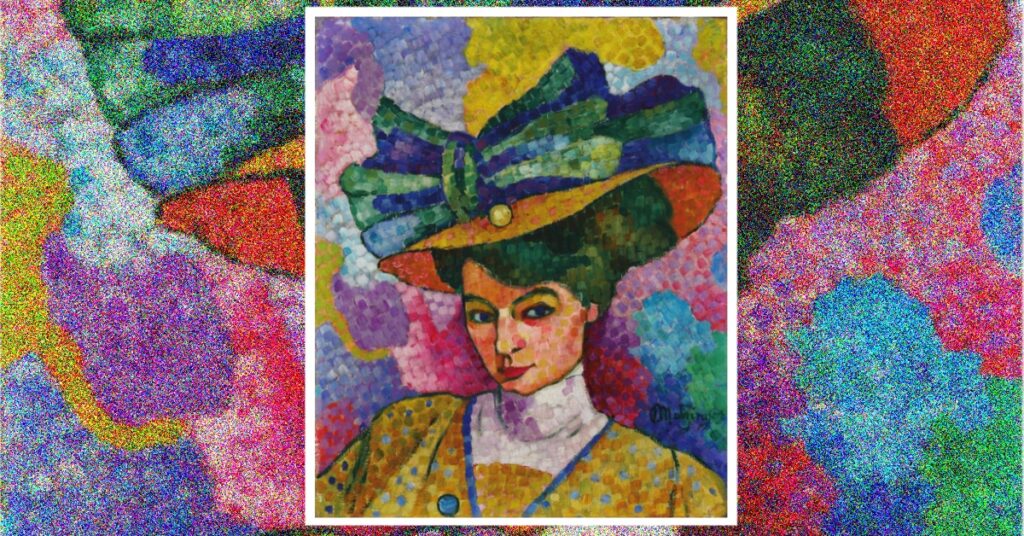
La Récolte des pommes by Jacob Abraham Camille Pissarro

Which art movement(s) came before the Pointillist movement?
Fauvism and Impressionism were the art movements that came before Pointillism.
Which art movement(s) came after the Pointillist movement?
Neo-impressionism and arguably mosaic art in both paintings and installations draw inspiration from pointillism.
Top 10 Artworks of the Pointillism Art Movement
The Pointillist Art Movement was one where painting texture was more of a focus than the subject, elements or anything else. Pointillism paintings almost had a contemporary look. This was a far cry from the typical European artworks that have very discernible landscapes and figures, almost like illustrations of a scene. Pointillism was a watershed moment when artwork started to become modern. Pointillism gave importance to both expression and technique.
A Sunday on La Grande Jette by Georges Seurat
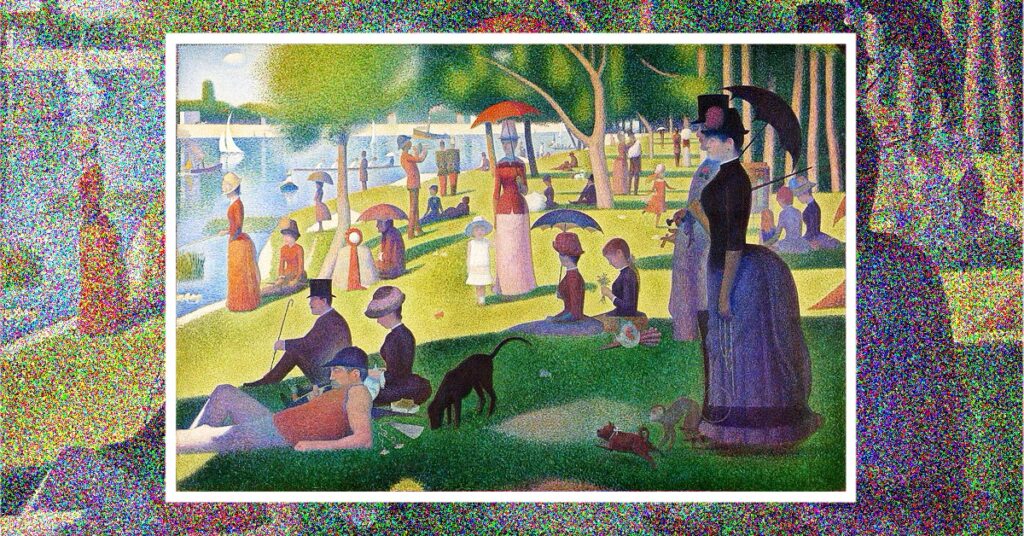
Georges Seurat’s “A Sunday on La Grande Jette” (1884-1886) is perhaps one of the most iconic Pointillist paintings. It depicts a leisurely scene along the banks of the Seine River, with people picnicking, strolling, and enjoying a day in the park. The painting is known for its detailed use of tiny dots of colour to create depth through texture.
Seurat’s commitment to scientific principles in his art was evident in “A Sunday on La Grande Jette.” He applied the theories of colour division and optical mixing to create a vibrant and harmonious scene. He studied the work of scientists and colour theorists to inform his approach to Pointillism.
The Circus by Georges Seurat
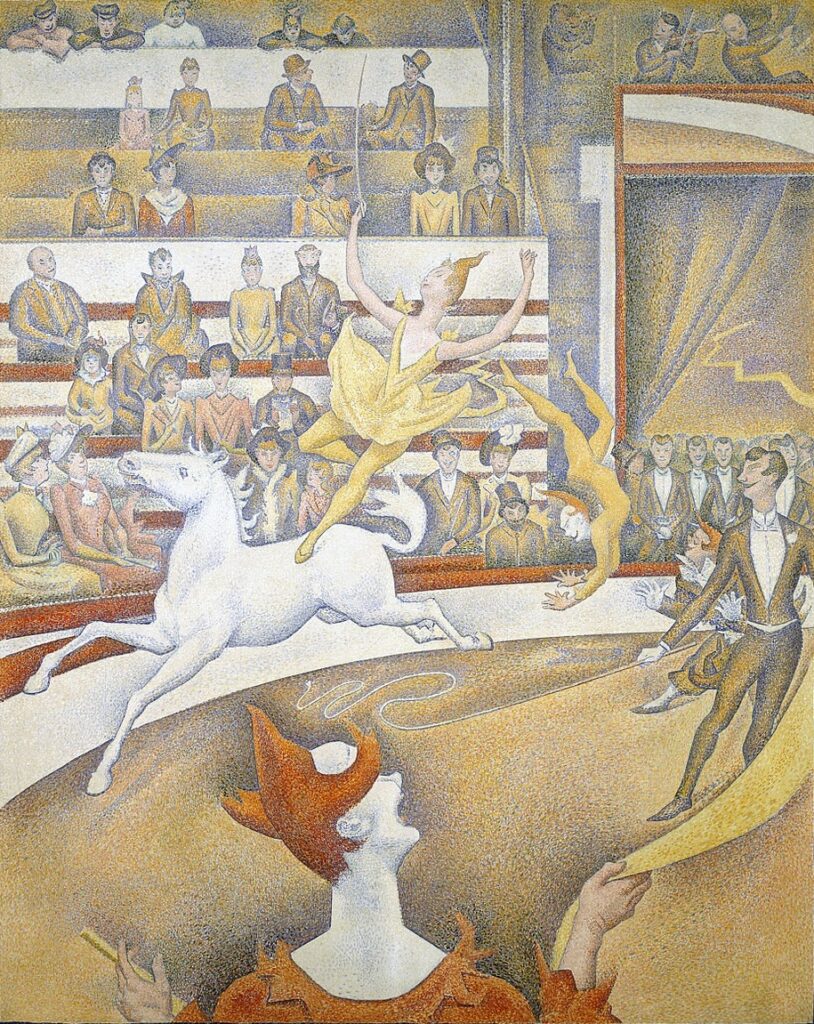
Georges Seurat’s “The Circus” (1890-1891) is another celebrated Pointillist work. It captures the ambience of a circus with acrobats, clowns, and spectators in a dazzling performance. The painting is remarkable for its ability to convey movement and light through the strategic arrangement of dots.
Seurat’s interest in the circus was sparked by his fascination with entertainment and the way it played with light and colour. He made numerous preliminary studies, both in sketches and oil studies, to grasp the essence of the circus and the movement of the performers.
Port-en-Bessin, Entrance to the Harbor by Georges Seurat

“Port-en-Bessin, Entrance to the Harbor” (1888) is a lesser-known work by Georges Seurat, but it is a testament to his mastery of the Pointillist technique. The painting depicts a coastal scene with boats, cliffs, and the entrance to the harbour, and it showcases Seurat’s ability to capture the nuances of light and atmosphere.
Seurat’s dedication to detail was evident in “Port-en-Bessin, Entrance to the Harbor.” He spent months working on the painting, making studies of the landscape and the effects of light. His approach to capturing the precise play of light on water and the texture of the cliffs shows his dedication to the practice.
The Pissarro Family by Camille Pissarro
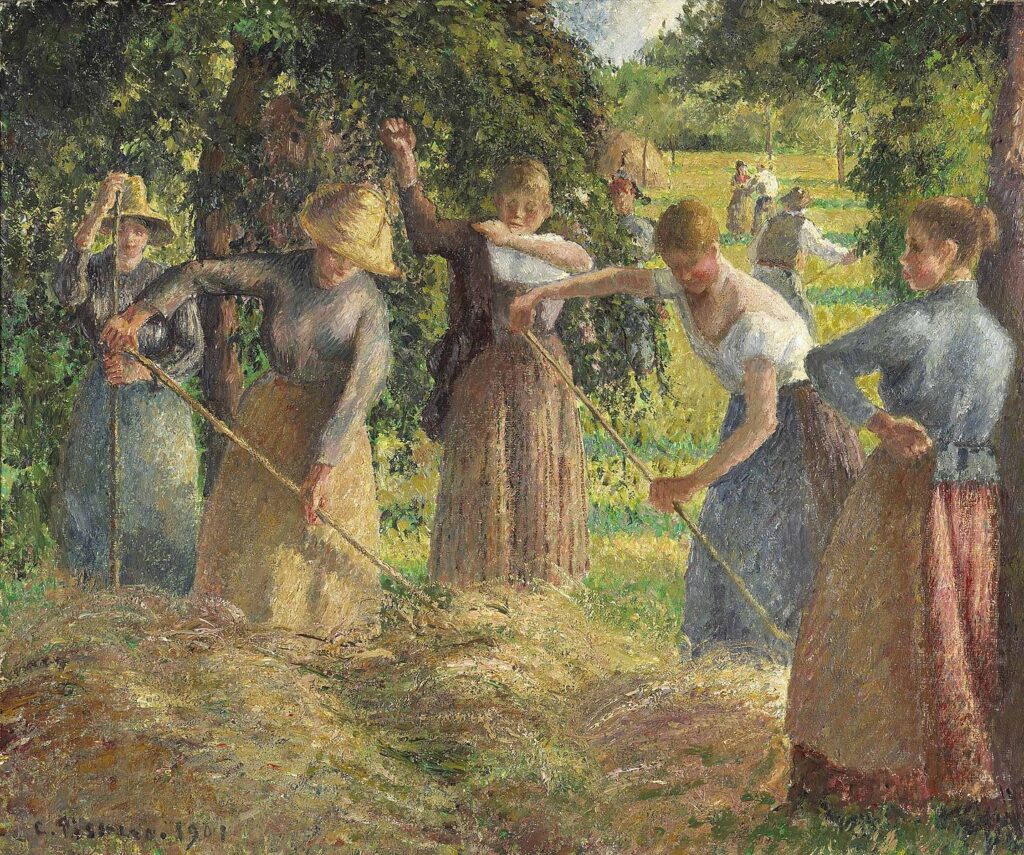
Camille Pissarro’s “The Pissarro Family” (1893) is a charming Pointillist painting that portrays the artist’s family in a relaxed, outdoor setting. The painting exemplifies the Pointillist technique and its ability to convey the effects of light and colour in an everyday scene.
Camille Pissarro was a key figure in the development of Pointillism, and his family often served as his models. In “The Pissarro Family,” he portrayed his wife and children in a casual, natural setting. The painting reflects Pissarro’s commitment to capturing the joy and spontaneity of family life.
The Bridge at Courbevoie by Georges Seurat

“The Bridge at Courbevoie” (1886-1887) is another fabulous piece by Georges Seurat. The painting depicts a modern urban scene, featuring a bridge, buildings, and people going about their daily lives. Seurat’s precise use of dots captures the vibrancy of the city and the interplay of light and shadow.
Seurat was captivated by the transformation of urban life in the late 19th century, and “The Bridge at Courbevoie” is a reflection of this fascination. He was thorough in his preparations for the painting, creating detailed studies of the architecture and the people he observed at the bridge.
The Seine at La Grande Jette by Paul Signac
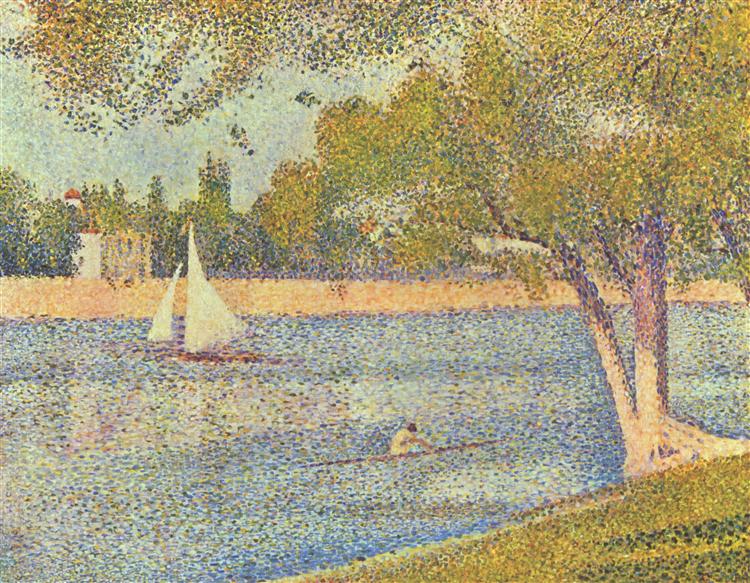
Paul Signac’s “The Seine at La Grande Jette” (1888) is a testament to his mastery of Pointillism. The painting captures the beauty of the Seine River and the surrounding landscape. Signac’s use of colour dots creates a vibrant and harmonious scene.
Paul Signac was a close associate of Georges Seurat and a dedicated proponent of Pointillism. He applied scientific principles to his art and often used complementary colours to create harmony in his works. “The Seine at La Grande Jette” reflects his fascination with the changing effects of light and atmosphere on the natural world.
The Channel of Gravelines, Grand Fort-Philippe by Georges Seurat
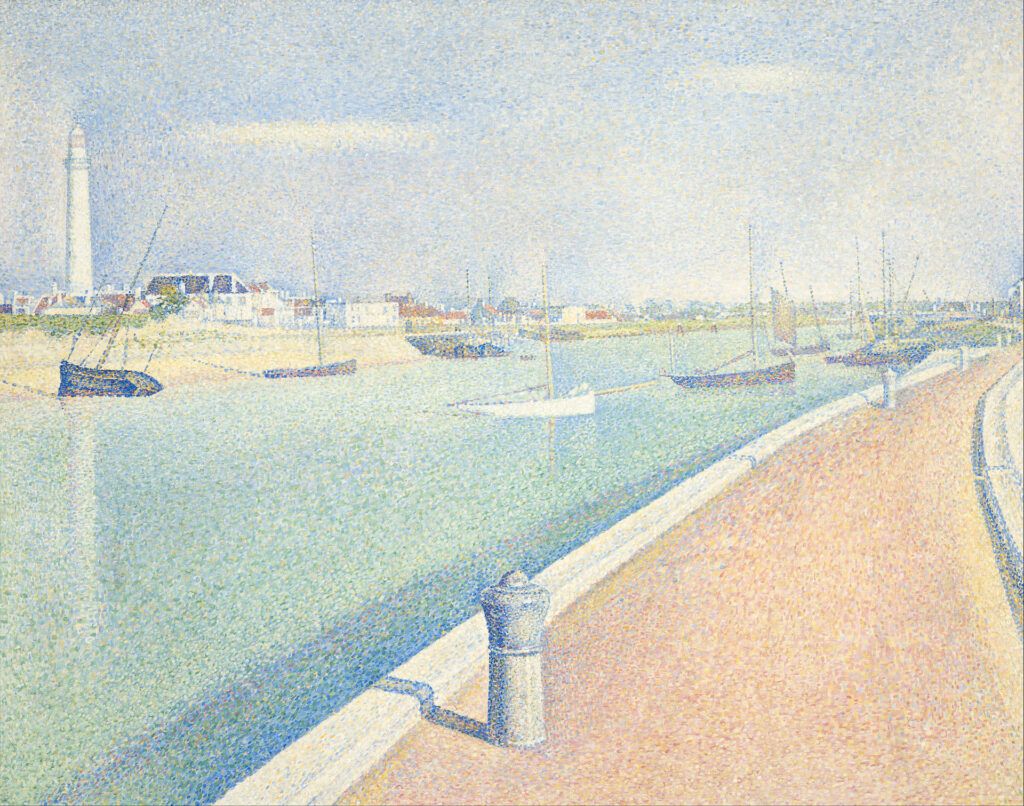
“The Channel of Gravelines, Grand Fort-Philippe” (1890) is a maritime scene painted by Georges Seurat. The artwork features a tranquil coastal view with boats and figures by the water’s edge. Seurat’s creative use of dots brings depth and luminosity to the scene.
Seurat’s interest in maritime scenes was influenced by his visits to coastal areas in France, where he sought to capture the changing effects of light on water and land. “The Channel of Gravelines” showcases his dedication towards capturing the feeling of the moment or rather, the “vibe” of the scenery through dots.
The Palace of Westminster by Maximilien Luce
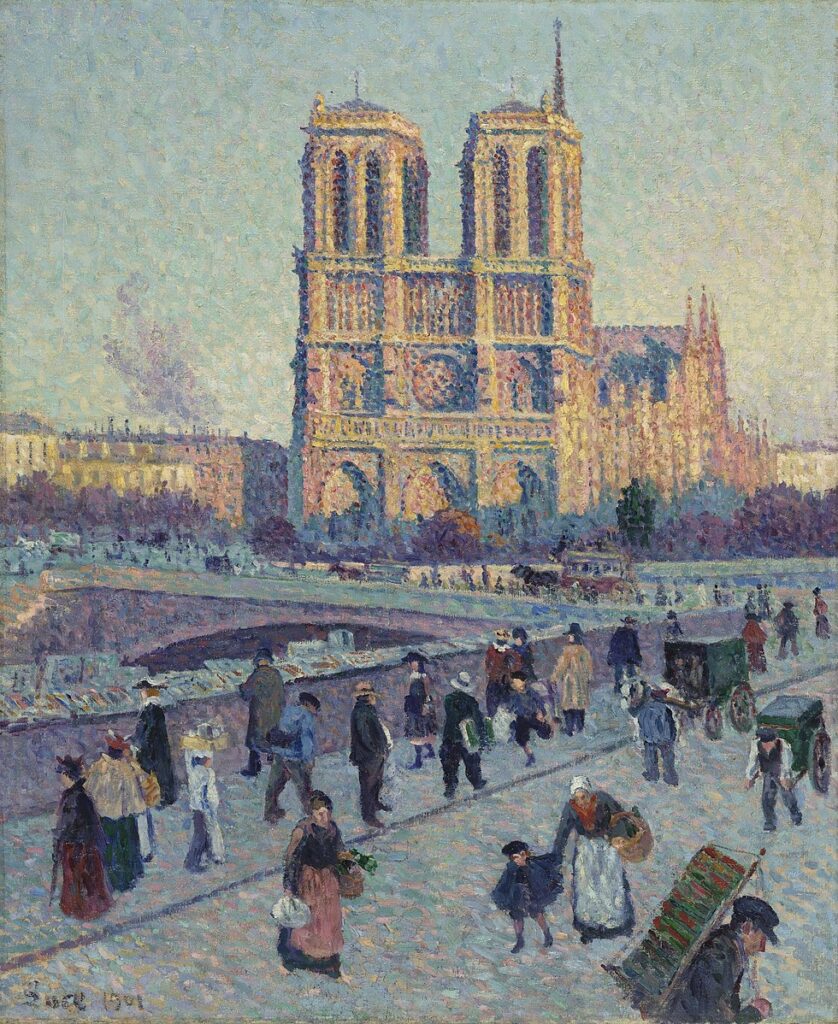
Maximilien Luce’s “The Palace of Westminster” (1890) is a magnificent portrayal of the iconic London landmark. The painting showcases the grandeur of the building and the movement of boats on the River Thames. Luce’s use of dots creates a vivid sense of light and reflection.
Maximilien Luce was a prolific Pointillist artist known for his urban and industrial scenes. His dedication to capturing the atmosphere of a location and the effects of light is evident in “The Palace of Westminster.” The painting reflects his ability to convey the dynamism and luminosity of the city.
The Seine at Courbevoie by Georges Seurat
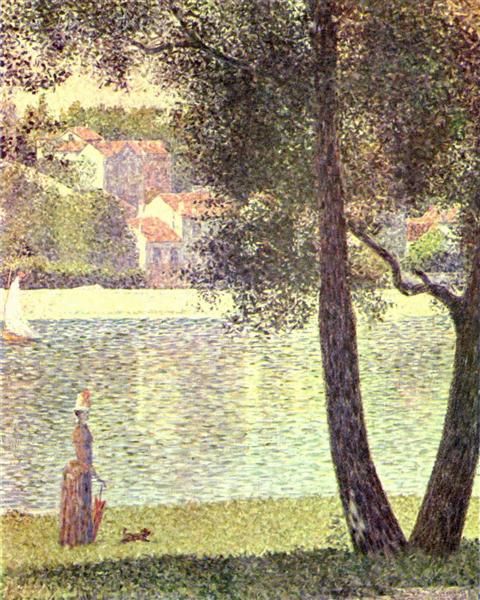
Georges Seurat’s “The Seine at Courbevoie” (1885) is a serene landscape painting that captures the beauty of the Seine River and the surrounding countryside. The artwork features a bridge and trees, and Seurat’s use of dots creates a sense of tranquillity in the still waters.
“The Seine at Courbevoie” is a reflection of Seurat’s ability to convey the nuances of light and colour in nature. He often painted en plein air (in the open air). He worked directly in front of the subject to capture the changing effects of light and atmosphere to ensure accuracy of light and shadows.
The Port of Saint-Tropez by Paul Signac

Paul Signac’s “The Port of Saint-Tropez” (1899) is a vibrant and dynamic Pointillist painting. It captured the bustling atmosphere of a port. The artwork features sailboats, figures, and the water’s edge. Signac’s use of colour almost creates a frame of cool colours to go around a scene of warm, bright colours.
Paul Signac was known for his love of travel and exploration. He often painted scenes of ports and coastal towns. “The Port of Saint-Tropez” showcases his dedication to capturing the liveliness of a location. Also, the interplay of light and colour in a marine setting.
The Pointillism art movement, with its meticulous use of tiny dots of colour, brought a new level of precision, technique and innovation in painting. These examples provide insights into the technique and creative processes of the artists who championed this unique style. Their dedication to capturing the effects of light, colour, and atmosphere in the world around them continues to captivate art enthusiasts and serves as a testament to the enduring impact of Pointillism in art.
*Images from Wiki Commons







0 Comments